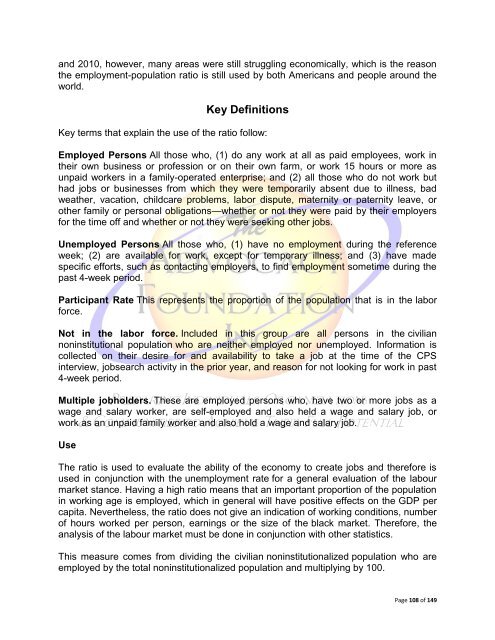Hidden Unemployment
Hidden Unemployment
Hidden Unemployment
Create successful ePaper yourself
Turn your PDF publications into a flip-book with our unique Google optimized e-Paper software.
and 2010, however, many areas were still struggling economically, which is the reason<br />
the employment-population ratio is still used by both Americans and people around the<br />
world.<br />
Key Definitions<br />
Key terms that explain the use of the ratio follow:<br />
Employed Persons All those who, (1) do any work at all as paid employees, work in<br />
their own business or profession or on their own farm, or work 15 hours or more as<br />
unpaid workers in a family-operated enterprise; and (2) all those who do not work but<br />
had jobs or businesses from which they were temporarily absent due to illness, bad<br />
weather, vacation, childcare problems, labor dispute, maternity or paternity leave, or<br />
other family or personal obligations—whether or not they were paid by their employers<br />
for the time off and whether or not they were seeking other jobs.<br />
Unemployed Persons All those who, (1) have no employment during the reference<br />
week; (2) are available for work, except for temporary illness; and (3) have made<br />
specific efforts, such as contacting employers, to find employment sometime during the<br />
past 4-week period.<br />
Participant Rate This represents the proportion of the population that is in the labor<br />
force.<br />
Not in the labor force. Included in this group are all persons in the civilian<br />
noninstitutional population who are neither employed nor unemployed. Information is<br />
collected on their desire for and availability to take a job at the time of the CPS<br />
interview, jobsearch activity in the prior year, and reason for not looking for work in past<br />
4-week period.<br />
Multiple jobholders. These are employed persons who, have two or more jobs as a<br />
wage and salary worker, are self-employed and also held a wage and salary job, or<br />
work as an unpaid family worker and also hold a wage and salary job.<br />
Use<br />
The ratio is used to evaluate the ability of the economy to create jobs and therefore is<br />
used in conjunction with the unemployment rate for a general evaluation of the labour<br />
market stance. Having a high ratio means that an important proportion of the population<br />
in working age is employed, which in general will have positive effects on the GDP per<br />
capita. Nevertheless, the ratio does not give an indication of working conditions, number<br />
of hours worked per person, earnings or the size of the black market. Therefore, the<br />
analysis of the labour market must be done in conjunction with other statistics.<br />
This measure comes from dividing the civilian noninstitutionalized population who are<br />
employed by the total noninstitutionalized population and multiplying by 100.<br />
Page 108 of 149

















